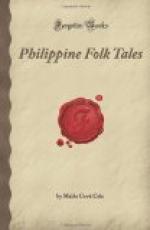[41] In their beliefs of today the Tinguian recognize many giants, some with more than one head. In a part of the ritual of one ceremony we read, “A man opens the door to learn the cause of the barking and he sees a man, fat and tall, with nine heads.”
[42] A large bamboo pole, with all but the end section cut out, serves for a water bucket.
[43] A long bamboo pole, in one end of which a hard-wood point is inserted. This is thrust into the ground, and in the hole thus made the grain or cuttings are planted. This old method is still in use in some sections of the mountains, but on the lowlands a primitive plow is used to break the soil.
[44] In European, Asiatic, African, and Malaysian lore we find stones of beings with star dresses: when they wear the dresses they are stars; when they take them off they are human. See Cox, An Introduction to Folklore, p. 121 (London, 1904.).
[45] note 1, p. 9.
[46] See note 1, p. 12.
[47] Preface, p. vii.
[48] It is the custom to have a small bamboo house built from fifteen to twenty feet from the ground near the rice fields, and in this someone watches every day during the growing season to see that nothing breaks in to destroy the grain. Often flappers are placed in different parts of the field and a connecting string leads from these to the little house, so that the watcher by pulling this string may frighten the birds away from the grain.
[49] See note 1, p. 18.
[50] Preface, p. vi.
[51] The nights in the mountains are cold, and it is not at all uncommon in the early morning to see groups of people with blankets wrapped tightly about them, squatting around small fires in the yards.
[52] See note 2, p. 12.
[53] See note 1, p. 13.
[54] See note 1, p. 17.
[55] Compare with the biblical story of the loaves and fishes. For similar incidents among the Igorot of the Philippines, in Borneo, and in India, see Jenks, The Bontoc Igorot, p. 202; Seidenadel, The Language of the Bontoc Igorot, pp. 491, 41 ff. (Chicago, 1909); Roth, The Natives of Sarawak and British North Borneo, Vol. I, p. 319; Tawney, Katha Sarit Sagara, Vol. II, p. 3 (Calcutta, 1880); Bezemer, Volksdichtung aus Indonesien, p. 49 (Haag, 1904).
[56] See note 1, p. 15.
[57] See note 3, p. 15.
[58] There appear to have been two classes of spirits, one for whom the people had the utmost respect and reverence, and another whom they looked upon as being of service to mortals.
[59] See note 1, p. 30.
[60] The word used in the original is langpadan, meaning mountain rice. This variety requires no irrigation and is planted to some extent at the present day, but the great bulk of the grain now used is grown in wonderfully terraced fields on the mountain sides, where water for irrigating is brought from distant streams through a system of flume and bamboo tubes. The fact that only the mountain rice is mentioned in the tales reflects a very ancient life before irrigated fields were known.




